WHAT DO YOU CALL US?
Meet a new species (form)
Cactus Magazine "Welwitschia". www.dpks-drustvo.si/FJournal.htm
Albino plants are not unknown phenomena. Their fortune is inexorable; when they use all the reserve food from cotyledons, they die. The photography shows an albino pea.
Green plants with chlorophyll and capability of photosynthesis were chosen by evolution as the most successful organisms producing organic matter from inorganic. Were on other planets the same rules, do there live plants that don't need chlorophyll? Are they yellow, red, white or blue instead of green? Will it be possible to breed them on the Earth?
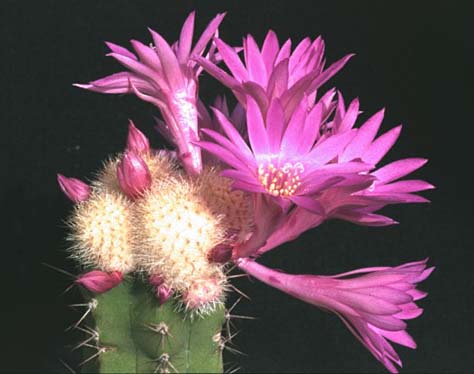 |
| Photo 1. Photo 1. Rebutia violaciflora 'Anchy' is not the first cactus without chlorophyll I have raised, though it is without doubt the most beautiful. The purple-pink petals are in a magnificent contrast to the pale yellowish body with white spines. The cultivar is named after my daughter Anja. Text and photo: Iztok Mulej. |
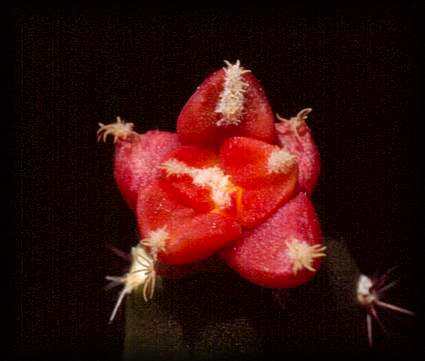 |
| Photo 2. Photo 2. (1995) Ariocarpus cv. rubra is a cross between A. retusus and A. kotschoubeyanus. Every year it became greener and lost its red color. After 6 years it died without any obious reason. What a pity. Photo: Jure Slatner. |
Maybe we can find some answers in breeding albino cacti, the only higher plants, that can survive without chlorophyll out of highly controlled laboratories. The story of albino cacti began in the forties of the previous century. We are very proud of the fact that some of such plants were bred in Slovenia.
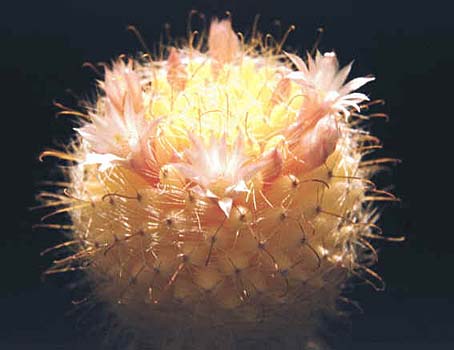 |
| Photo 3. Photo 3. Mammillaria wildii cv. aurea was the first albino cactus breed in Slovenia. It blooms every spring, about a month later than normal plants. Flowers are opened only in full sun but it are sterile. Any water from the top causes ugly damages.. Photo: Jure Slatner. |
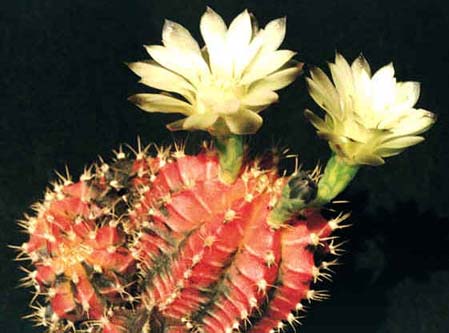 |
| Photo 4. Photo 4. The first cactus without chlorophyll raised by I. Mulej. The seeds were obtained after cross-pollination of a red and black G. michanovichii cultivars. Photo: Iztok Mulej. |
PROBLEMS WITH IDENTIFICATION
Only a few species of cacti are really easy to identify. The most obvious identifying signs are the shape, number and arrangement of the spines, the number and shape of ribs and warts, and the colour of flowers. Flowers of albino cacti are frequently deformed, quality of spines sometimes depend of the stock. We can depend on the origin of the seeds, if we produce them ourselves. The hybrids found at home or in nature cause the most problems. Albino specimens are significant, even as hybrids.
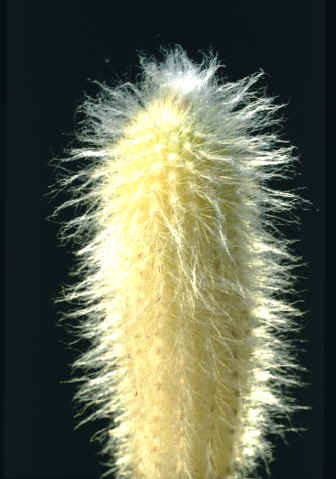 |
| Photo 5. Photo 5. Espostoa lanata cv. lutea is hiding its colour under the thick bristles. Photo: Jure Slatner. |
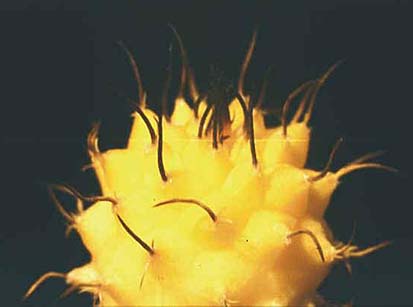 |
| Photo 6. Photo 6. Turbinicarpus cv. aurea changes its colour in the seasons of the year. In late autumn and in winter it is almost red, in spring and summer it is golden yellow. The flowers are sterile. Photo: Jure Slatner. |
The cells possess a few functional chloroplasts, but not enough to show the colour. Mitosis can separate the cell coincidentally in the A - B direction or the C - D direction. If the direction is A - B, both daughter cells are not green and tissue that arises from them is the same colour as before. In the C - D direction, one of the new cells has enough chloroplasts, and tissue from that cell can be more or less green. The opposite seems to happen when a yellow or red offset arises from a normal green plant (after Muntzing 1967).





